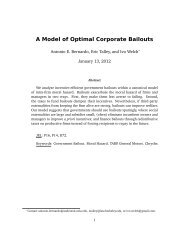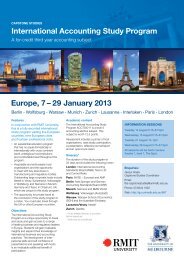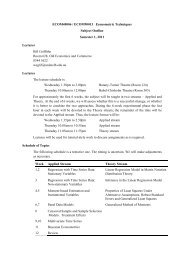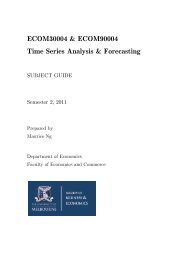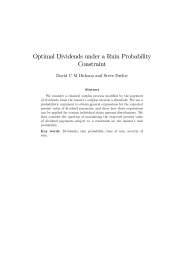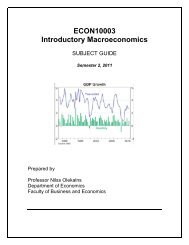Bayesian Inference in the Seemingly Unrelated Regressions Model
Bayesian Inference in the Seemingly Unrelated Regressions Model
Bayesian Inference in the Seemingly Unrelated Regressions Model
You also want an ePaper? Increase the reach of your titles
YUMPU automatically turns print PDFs into web optimized ePapers that Google loves.
16<br />
G. A Metropolis-Hast<strong>in</strong>gs Algorithm<br />
An alternative to Gibbs sampl<strong>in</strong>g is a Metropolis-Hast<strong>in</strong>gs algorithm that draws<br />
observations from <strong>the</strong> marg<strong>in</strong>al posterior pdf f( β | y)<br />
. As we will see, this algorithm<br />
is particularly useful for an <strong>in</strong>equality-restricted prior, or if <strong>the</strong> equations are<br />
nonl<strong>in</strong>ear. The algorithm we describe is a random-walk algorithm; it is just one of<br />
many possibilities. For o<strong>the</strong>rs see, for example, Chen et al (2000).<br />
The Metropolis–Hast<strong>in</strong>gs algorithm generates a candidate value β * that is<br />
accepted or rejected as a draw from <strong>the</strong> posterior pdf f( β | y)<br />
. When it is rejected, <strong>the</strong><br />
previously accepted draw is repeated as a draw. Thus, rules are needed for generat<strong>in</strong>g<br />
<strong>the</strong> candidate value β * and for accept<strong>in</strong>g it. Let V be <strong>the</strong> covariance matrix for <strong>the</strong><br />
distribution used to generate a candidate value. The maximum likelihood covariance<br />
matrix is usually suitable. For <strong>the</strong> l<strong>in</strong>ear SUR model this matrix is<br />
[ X′ ( Σˆ<br />
⊗ I ) X]<br />
.<br />
−1 −1<br />
T<br />
Choose a feasible start<strong>in</strong>g value β<br />
(0)<br />
. The follow<strong>in</strong>g steps can be used to draw <strong>the</strong><br />
( $ + 1) −th<br />
observation <strong>in</strong> a random walk Metropolis–Hast<strong>in</strong>gs cha<strong>in</strong>.<br />
1. Draw a candidate value β * from a<br />
( )<br />
β $<br />
N( , cV)<br />
distribution where c is a<br />
scalar set such that β * is accepted approximately 40-50% of <strong>the</strong> time.<br />
2. Compute <strong>the</strong> ratio of <strong>the</strong> posterior pdf evaluated at <strong>the</strong> candidate draw to<br />
<strong>the</strong> posterior pdf evaluated at <strong>the</strong> previously accepted draw.<br />
r =<br />
f<br />
( β*<br />
| y)<br />
( )<br />
β $ y<br />
f( | )<br />
Note that this ratio can be computed without knowledge of <strong>the</strong> normalis<strong>in</strong>g<br />
constant for f( β | y)<br />
. Also, if any of <strong>the</strong> elements of β * fall outside a<br />
feasible parameter region def<strong>in</strong>ed by an <strong>in</strong>equality-restricted prior (see



